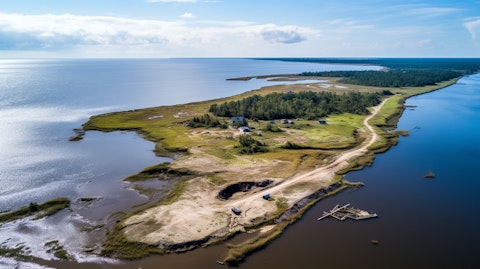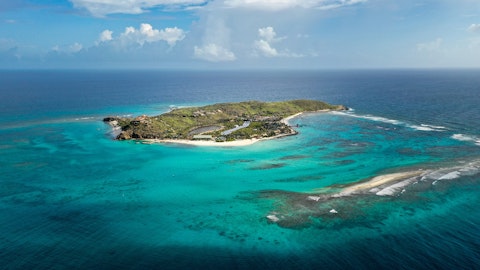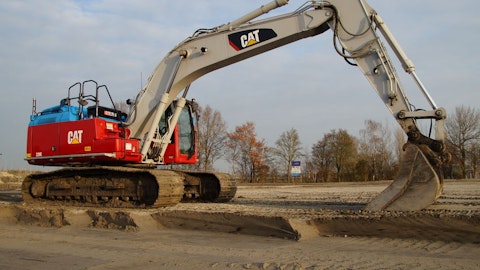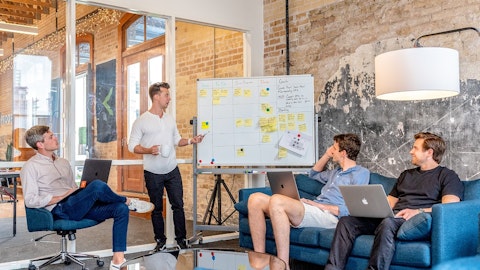Great Lakes Dredge & Dock Corporation (NASDAQ:GLDD) Q4 2023 Earnings Call Transcript February 14, 2024
Great Lakes Dredge & Dock Corporation beats earnings expectations. Reported EPS is $0.32, expectations were $0.09. Great Lakes Dredge & Dock Corporation isn’t one of the 30 most popular stocks among hedge funds at the end of the third quarter (see the details here).
Operator: Good day, and thank you for standing by. Welcome to the Q4 2023 Great Lakes Dredge & Dock Corp. Earnings Conference Call. At this time, all participants are in a listen-only mode. After the speaker’s presentation, there will be a question-and-answer session. [Operator Instructions] Please be advised today’s conference is being recorded. I would now like to introduce your host for today’s conference, Ms. Tina Baginskis, Director of Investor Relations. Please go ahead.
Tina Baginskis: Thank you. Good morning, and welcome to our fourth quarter 2023 conference call. Joining me on the call this morning is our President and Chief Executive Officer, Lasse Petterson, and our Chief Financial Officer, Scott Kornblau. Lasse will provide an update on the events of the quarter and the year, then Scott will continue with an update on our financial results for the quarter and the year. Lasse will conclude with an update on the outlook for the business and market. Following their comments, there will be an opportunity for questions. During this call, we will make certain forward-looking statements to help you understand our business. These statements involve a number of risks, uncertainties and other factors that could cause actual results to differ materially from our expectations.
Certain risk factors inherent in our business are set forth in our earnings release and in filings with the SEC, including our 2022 Form 10-K and subsequent filings. During this call, we also refer to certain non-GAAP financial measures, including adjusted EBITDA, which are explained in the net income to adjusted EBITDA reconciliation attached to our earnings release and posted on our Investor Relations website, along with certain other operating data. With that, I will turn the call over to Lasse.
Lasse Petterson: Thank you, Tina. As expected, 2023 was a year of positive transition from the difficult 2022, and we ended the year strong with improved performance, stronger financial results and a record backlog of $1.04 billion, which does not include approximately $179 million of low bids and options pending award and approximately $44 million of performance obligations related to offshore wind contracts. The bid market gained momentum throughout the course of the year in our preferred port deepening and coastal protection markets. We ended the year with 71% of our backlog in capital projects with four major awards, including the Freeport Deepening Project, the Sabine-Neches Waterway Channel Improvement Project, and two large port deepening projects related to Liquified Natural Gas, LNG, projects, the Port Arthur LNG Phase 1 and the Next Decade Corporation’s Rio Grande LNG projects.
The latter is the largest project that were undertaken by Great Lakes. These two projects are not impacted by the recent White House announcements regarding a pause on new LNG export projects permitting. As we have navigated the challenging market conditions in ’22 and ’23, we have remained focused on staying a competitive market leader for the long term. We have implemented cost reductions initiatives, including strong reductions in our G&A and overhead cost structures and we are modernizing our fleet with our ongoing newbuild program and retirement of older, less productive dredges, such as the Terrapin Island in ’22 and the Dredge 53 in ’23. We have now taken delivery on our newest 6,500 cubic yard capacity hopper dredge, the Galveston Island, and we did that in December last year.
Her sister ship, the Amelia Island, is expected to be delivered in 2025. Also in ’23, we took delivery of our two Multi Cats, the Cape Hatteras and the Cape Canaveral, which will now be efficient tools for mobilizing and demobilizing our pipelines as well as general operation support. And we took delivery of three new scows replacing older equipment last year. Towards the end of 2023, the offshore wind markets started to see growing pains. We saw several cancellations by developers of power purchase agreements or PPAs that were entered into in 2018 and 2019 before COVID, inflation and interest rate increases were a reality. The East Coast states also continue to invite new bids for new PPAs, which included the opportunity to increase the base rates to the new realities and to include inflation adjustments going forward.
Our clients, the Equinor-BP joint venture decided to reset the plan for Empire Wind II wind farm and to cancel our rock installation contract scheduled for 2026. Equinor is continuing the Empire I development as previously planned, and we will have the opportunity to retender the Empire Wind II contract when Equinor rebids their PPA for this development. In December of ’23, we were awarded a new rock installation contract to perform rock protection over subsea power cables, a new utilization for this vessel on an offshore wind project off the East Coast of the United States. Going forward, we continue to pursue and bid a number of other offshore wind farm projects, both domestically and internationally, with Rock installations planned for 2026 and beyond.
We believe the offshore wind market power generation market offers Great Lakes a strong opportunity for growth in a rapidly growing market, which also provides us with an opportunity to diversify our business and our client base. I’ll now turn the call over to Scott to further discuss the results for the quarter, and I’ll provide further commentary around the market and our business.
Scott Kornblau: Thank you, Lasse, and good morning, everyone. I’ll start by walking through the fourth quarter, which resulted in the strongest EBITDA quarter we’ve had since the end of 2021. For the fourth quarter of 2023, revenues were $181.7 million, net income was $21.6 million and adjusted EBITDA was $40.8 million. Revenues of $181.7 million in the fourth quarter of 2023 increased $35.1 million from the prior year fourth quarter primarily due to higher utilization and higher coastal protection, maintenance and offshore wind revenues offset partially by a decrease in rivers and lakes project revenue. Current quarter gross profit and gross profit margin increased to $38.7 million and 21.3%, respectively, compared to negative $16.2 million and negative 11%, respectively, in the fourth quarter of 2022.
The increase in gross margin is primarily due to improved project performance, utilization and approximately $20 million of lower operating costs due to our continued focus on cost reductions and efficiencies. Fourth quarter 2023 G&A of $15.4 million is $3 million higher than the same quarter last year, primarily due to higher incentive and severance pay in the current year quarter partially offset by our continued cost-cutting initiatives. Current quarter’s operating income of $30.5 million improved $67.2 million from the prior year’s quarter operating loss of $36.7 million, driven by the improved gross profit, a $7.4 million gain related to the recently terminated offshore wind contract and the nonrepeating fourth quarter 2022 write-down of the hopper dredge Terrapin Island after she was retired, partially offset by the previously discussed increase in G&A.

Net interest expense of $2.8 million for the fourth quarter of 2023 was down from $3.1 million in the fourth quarter of 2022, primarily due to an increase in capitalized interest related to our newbuild program partially offset by current quarter revolver interest expense. Fourth quarter 2023 net income tax expense of $6.2 million compared to an $8.4 million net income tax benefit in the same quarter of 2022 is driven by the higher current quarter income. Rounding out the P&L, net income for the fourth quarter 2023 was $21.6 million, up from a $31.2 million net loss in the prior year quarter. Turning now to our full year results. Revenue for 2023 was $589.6 million, net income was $13.9 million and adjusted EBITDA was $73 million. Despite a $59.2 million decrease in year-over-year revenue, gross profit margin increased from 4.8% to 13.2%, net income increased $48 million and adjusted EBITDA increased $56 million, driven by stronger project performance and improved efficiencies.
Turning to our balance sheet. We ended 2023 with $22.8 million in cash and $90 million drawn on our $300 million revolver, which doesn’t mature until the third quarter of 2027. So far this year, we have paid down $15 million and currently have $75 million drawn against the revolver. During the fourth quarter, we closed on a sale leaseback of various support equipment, bringing in approximately $29 million of cash. Total capital expenditures for 2023 were $144.8 million, which includes $64.5 million for the construction of the subsea rock installation vessel, the Acadia, $36.3 million for the Amelia Island, $24.8 million for the Galveston Island, $9.2 million for our recently delivered Multi Cats and $10 million for maintenance CapEx. As previously discussed, a little over a year ago, we applied with the Maritime Administration or MARAD for Title XI financing on our new vessel, the Acadia.
The recent offshore wind headlines, including the canceled PPAs Lasse discussed earlier, has slowed down the progress of our Title XI application. While we continue our conversations with MARAD, we have shifted our focus and are actively pursuing other financing that can either be a bridge to a Title XI loan or the primary funding source to support and complete our new build program. These discussions are progressing quickly, and I am confident we are on a good path to secure additional financing soon. I will provide updates in the future as appropriate. Looking forward to 2024, we expect approximately 60% of our $1 billion backlog to be converted into revenue during the year. This can fluctuate higher or lower as vessel schedules adjust throughout the year.
We currently have three regulatory dry dockings planned for 2024, with two starting in the first quarter and a third plan for the second half of the year. But as always, the number and timing of dry dockings is subject to change. We expect full year 2024 capital expenditures to be between $170 million and $195 million, which includes approximately $20 million of maintenance CapEx. The timing of these payments is dependent on when certain milestones are reached on the new builds, but we expect the heaviest spend to occur in the middle of the year. Looking towards the first quarter, we have two dredges beginning the regulatory dry docking that will continue into the second quarter. Partially offsetting those down days is the addition of the Galveston Island, which began operations earlier this month.
With that, I’ll turn the call back to Lasse for his remarks on the outlook moving forward.
Lasse Petterson: Thank you, Scott. The US dredging bid market for 2023 was at a record $2.8 billion, of which Great Lakes won 46%. This includes the over $500 million of capital port deepening projects for LNG developments that Great Lakes was awarded. We continue to see strong support from the administration and Congress for infrastructure developments, including new maritime and port deepening, widening and maintenance projects requiring dredging. In March of ’23, President Biden released the President’s fiscal year 2024 Executive budget. The proposed amount for the US Army Corps of Engineers was $7.4 billion, which is a record amount for a President’s budget. And in June of ’23, the House proposed an increased 2024 budget of $9.6 billion for the Corps, which is $910 million above the fiscal year 2023.
And in July of ’23, the Senate Committee for Appropriations passed the budget, which includes $8.9 billion for the Corps. This proposed budget is expected to provide for a strong 2024 US Army Corps of Engineers bid market and we expect budgeted appropriations to support the funding of several previously delayed phases of capital port improvement projects, including for the ports of Sabine, Houston and Mobile, which is expected to bid in the first half of 2024. Currently, the government is continuing — is operating under a continuing resolution until the budget is approved, which we hope is done in March of this year. As stated earlier, towards the end of 2023, the offshore wind market started to see growing pace. However, the long-term outlook sfor the offshore wind market continues to be strong in the US and international with global installed offshore wind power generation capacity targeted to reach 260 gigawatts by 2030, up from 40 gigawatts in operation in 2020.
And in the US, the targets are for 50 gigawatts by 2035. These are ambitious targets, and it will challenge the existing supply chains at the same time as it provides strong growth opportunity for the industry. Although New York rejected the developers request for adjustments to their existing PPAs, the State continues to take a step forward in meeting the renewable energy goals with the announcement in October last year of three new projects awarded for approximately 4 gigawatts of offshore wind power generation and a new accelerated fourth bid round for additional PPAs was announced for early 2024. Vineyard Wind, the first commercial scale offshore wind farm on the East Coast, recently completed the installation of the first offshore wind turbine, which on January 2nd of this year, began delivering power to the New England grid.
In addition, South Fork wind, which will be the first offshore wind farm to supply power to the state of New York has completed the installation of two of its 12 planned turbines, on which one currently is operational now in January. And recently, also in January, the New Jersey Board of Public Utility selected two projects to deliver 3.7 gigawatts of offshore wind power generation for the state. With these awards, New Jersey has now 5.2 gigawatts contracted out of its goal of 11 gigawatts by 2040. Great Lakes has established a unique niche business position in the US offshore wind market, and we continue to pursue in tender bids, both domestically and internationally on multiple offshore wind projects for the Acadia, the first and only Jones Act compliant subsea rock installation vessel.
We are also actively seeking for partners that share our ambition for growth in offshore wind, and that will co-invest in assets to address this rapidly growing market. In conclusion, our main focus this year was to keep managing through the various channels that the 2022 delayed bid market presented us, and we successfully delivered improved year-over-year results. And as we enter the New Year with a record backlog, improved fleet and a slimmer cost structure, we believe the company is positioned to deliver improved year-over-year results this year as well. And with that, I’ll turn the call over for questions.
See also Top 20 Biggest Mortgage Companies in the US and 12 Younger Woman Older Man Dating Sites in the US.
Q&A Session
Follow Great Lakes Dredge & Dock Corp (NASDAQ:GLDD)
Follow Great Lakes Dredge & Dock Corp (NASDAQ:GLDD)
Operator: [Operator Instructions] And our first question is going to come from the line of Adam Thalhimer with Thompson Davis. Your line is open. Please go ahead.
Adam Thalhimer: Hey, guys. Congrats on the strong Q4. That was great to see.
Lasse Petterson: Thank you.
Adam Thalhimer: I actually wanted to start, why does the — why did the MARAD timing shift? I was kind of curious about that from a couple of PPAs that kind of surprised me that, that would matter that much. Well, let’s start there. How about that?
Scott Kornblau: Yeah. Good morning, Adam. So with — as you know, we’ve been talking to MARAD now for over a year, and our application has progressed. And as you saw a few months ago, we did get to the final stage. However, as they were continuing their diligence during some of these negative headlines, it did change how they just look at the market in general today. There is a path for us to get something done now. It is not at terms that work for us. So I’ve been very transparent all along. We were not going to put all of our eggs in the MARAD basket, and we’re working a number of things in parallel. We will now action those. We will continue our dialogue with MARAD. I do think there is a path to ultimately get there. But in the meantime, we’ll secure the liquidity and hopefully be able to take it out at some point with MARAD. If not, we’re very comfortable that we’re going to be in a very good liquidity position soon.
Adam Thalhimer: Got it. Okay. That’s fine. Just a little surprising on — from their perspective. The — Scott, how would you characterize margins? The margins are — gross margin, 21% in Q4. That was completely unaffected by the cancellation payments. So that’s a real number. How do you think that trends going forward?
Scott Kornblau: Yeah. So we started executing on the capital and coastal protection work during the fourth quarter. We also, though, were benefited by not having any dry docks during the quarter, we got them all out during the first three quarters. So we had pretty clean cost structure. As I mentioned, we do have two dry dockings beginning this quarter and will go into the second quarter. So as you know, that’s kind of the double whammy, no revenue during that time and then the cost to do that. But this has been our expectation all along when you have that proper mix of projects and the vessels are working and we execute in addition to the cost reset that we have done on the fleet. We’ve been saying for the last year, we thought that we were on this path to normalcy in 2024, and that’s exactly how it’s playing out.
Adam Thalhimer: That’s good to see. And then did you — I guess, it will be in the 10-K, but did you guys give a figure for percentage of backlog that will burn in ’24?
Scott Kornblau: Yeah. I said roughly 60%. But again, as you know, that can move left to right as we adjust schedules throughout the year, but it’s roughly 60%.
Adam Thalhimer: All right. I’ll turn it over. Great to see you. Thanks, guys.
Operator: Thank you. And one moment as we move on to our next question. And our next question is going to come from the line of Joe Gomes with Noble Capital. Your line is open. Please go ahead.
Joe Gomes: Good morning. Thanks for taking my questions.
Lasse Petterson: Hey, good morning, Joe.
Joe Gomes: So I just wanted to kind of get on your expectations for the quarter. I mean it was really good, but on the revenue side, it seemed a little light in the Q, you mentioned you should have burned about 19% of the dredging backlog in the fourth quarter, which would have been about $190-plus million. Was there some weather issues there, some projects that might have been delayed? And kind of at the same time, on the capital projects, revenue was up about $7 million sequentially. It’s kind of flat year-over-year. I was thinking maybe we would have been looking for a little bit higher run rate on the capital projects. Was there anything particular there that might have reduced the revenue growth in that segment?
Scott Kornblau: No. The big driver of the revenue we’re expecting compared to what came in is really driven by some subcontractor work on the LNG project. It is now underway. We had thought it would start earlier in the fourth quarter. It started later. That’s really what’s driving it. And you’re right, the capital revenue was relatively flat, but the coastal protection was way up, and those also have very solid margins. And of the — so the capital work now will start getting executed of the just over $1 billion backlog, 71% of that backlog is made up of capital projects.
Joe Gomes: Okay. Thanks for that. And on the determination of the Rock contract, obviously, you got, I think it was at $7.4 million. Is there anything more there or is that all that you will get for that?
Scott Kornblau: So you may have noticed, Joe, in the press release when we broke out revenue that there was an additional roughly $2.5 million of revenue. That is related to engineering and project management services that had already been performed on Empire II prior to the data termination. So once it was terminated, we went ahead and booked that. So all in all, for Empire II, between the termination and the services previously before, it’s roughly $10 million. And we do have similar constructs on our other two contracts related. There are some services that do occur before we lay rock.
Joe Gomes: Okay. And one last one for me, if I may, and I’ll get back in queue. You entered again some additional asset sales in the quarter. I think you said you raised $29 million of cash. Do you see more of those here in ’24? Are you kind of through with the asset sales?
Scott Kornblau: Yeah. It’s a lever we can’t pull, Joe, but I don’t foresee us doing that. As I mentioned, we’re progressing rather quickly, some longer-term financing for the newbuild program. So I do not see us doing anything more like that in 2024.
Joe Gomes: Great. Thanks for taking the questions.
Scott Kornblau: Thanks, Joe.
Operator: And one moment for our next question. And our next question comes from the line of Jon Tanwanteng with CJS Securities. Your line is open. Please go ahead.
Jon Tanwanteng: Hi, good morning. Thanks for taking my questions and great quarter. Lasse, I was wondering if you could tell us if you guys internally have line of sight to full utilization on the Acadia in the ‘26 time frame or if that’s still to be determined and kind of how that scores [indiscernible] thinking.
Lasse Petterson: Yeah, the cancellations of these PPAs over the last, let’s say, six months, has pushed some of that revenue to the right. So what we are looking at is ’25 when the vessel comes out, the Empire Wind I is going to be executed. And then we have an additional contract for 2026. Also the delays on these other developments are pushing projects revenues or project opportunities from ’24 and ’25 into ’26 and ’27. But this remains to be seen. We are looking for and bidding a number of projects starting in ’26. And for rock installation, but there is no firm commitments at this point in time. In parallel, we are looking at international work. There is a good strong market in Europe that we are evaluating and that we may participate in this period.
Jon Tanwanteng: Okay. Great. Thank you. And just relative to the 60% of the backlog that you expect to book this year. Can you remind me what your historical level of book and bill during the year is or book and burn kind of what you go and get within the year and revenue during the year?
Scott Kornblau: Yeah. And Jon, I would say this year is going to just be a little atypical because of the large backlog that we have right now. So we don’t have as much white space entering a year that we typically would with over $600 million of 2024 revenue “in the bank right now”. So I wouldn’t necessarily draw a parallel to prior years. I would say typically, when we enter a year, we roughly have 60% like we do now of coverage, but it’s on a much lower backlog. So again, the amount of white space we have in 2024 looks much different than it has historically.
Jon Tanwanteng: Okay. Great. That’s fair. And are there any remaining claims to be settled on older projects?
Scott Kornblau: Nothing material. I say we clear out the big ones that we had previously talked about, and now it’s just kind of the normal cadence that pops up, but really nothing of note to call out.
Jon Tanwanteng: Okay. Great. And last one for me, and then I’ll leave it at that. Just the year-over-year impact of dry docks, what do you expect that to be in ’23 versus ’24? I think you’ve disclosed the number, but I don’t know if you have a revenue or EBITDA comparator and kind of how that flows through?
Scott Kornblau: No. I mean just — we’re going to have three this year in 2024, that was comparable to what we had last year. So I would call it marginally a wash. I don’t see any big swings when it comes to dry docking ’23 versus ’24.
Jon Tanwanteng: Okay, great. Thanks guys.
Operator: Thank you. And one moment for our next question. And our next question is going to come from the line of Brian Russo with Sidoti. Your line is open. Please go ahead.
Brian Russo: Hi, good morning.
Lasse Petterson: Hey, good morning, Brian.
Brian Russo: So just back on the fourth quarter. If you look at the EBITDA margin, excluding the gain, it was a little over 18%. And when I look back at the fourth quarter for the years 2018 to ’21, it was about 16% to 21%. So right — smack in the middle of that range. But that’s despite the capital projects only generating 34% of the total 4Q revenue, which is below the 40% to 50% of the revenue in prior fourth quarters. So I’m just guessing, is this fourth quarter in your opinion considered normalized or is it still below — it’s below the optimal kind of 50-50 mix that you guys target and we’ll likely see in 2024, given the backlog profile?



